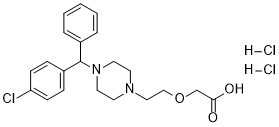This product is for research use only, not for human use. We do not sell to patients.

| Size | Price | Stock |
|---|---|---|
| 10g | $250 | Check With Us |
| 25g | $450 | Check With Us |
| 50g | $675 | Check With Us |
Cat #: V1218 CAS #: 83881-52-1 Purity ≥ 98%
Description: Cetirizine 2HCl (P-071; UCB P071; Reactine; Zyrtec; Alerlisin; AC-170; P071), the dihydrochloride salt of cetirizine and a major active metabolite of hydroxyzine, is a 2nd-generation antihistamine used in the treatment of allergies, hay fever, angioedema, and urticarial etc.
Publications Citing InvivoChem Products
Product Promise

- Physicochemical and Storage Information
- Protocol
- Related Biological Data
- Stock Solution Preparation
- Quality Control Documentation
| Molecular Weight (MW) | 461.81 |
|---|---|
| Molecular Formula | C21H25ClN2O3.2HCl |
| CAS No. | 83881-52-1 |
| Storage | -20℃ for 3 years in powder formr |
| -80℃ for 2 years in solvent | |
| Solubility In Vitro | DMSO: 92 mg/mL (199.2 mM)r |
| Water: 92 mg/mL (199.2 mM)r | |
| Ethanol: <1 mg/mL | |
| Solubility In Vivo | Chemical Name: 2-[2-[4-[(4-chlorophenyl)-phenylmethyl]piperazin-1-yl]ethoxy]acetic acid;dihydrochloride InChi Key: PGLIUCLTXOYQMV-UHFFFAOYSA-N InChi Code: InChI=1S/C21H25ClN2O3.2ClH/c22-19-8-6-18(7-9-19)21(17-4-2-1-3-5-17)24-12-10-23(11-13-24)14-15-27-16-20(25)26;;/h1-9,21H,10-16H2,(H,25,26);2*1H SMILES Code: C1CN(CCN1CCOCC(=O)O)C(C2=CC=CC=C2)C3=CC=C(C=C3)Cl.Cl.Cl |
| Synonyms | UCB-P071; P071; Reactine; Zyrtec; Alerlisin; UCBP071; P-071; Cetirizine Hydrochloride; P 071; UCB P071; Cetirizine Dihydrochloride |
| Protocol | In Vivo | Cetirizine (20 mg/kg, mice, orally) exerts its anti-inflammatory effects by inhibiting MIF as well as IL-8 production in mice immunized and challenged with ragweed pollen |
|---|---|---|
| Dosages | 2 or 20 mg/kg |
| Solvent volume to be added | Mass (the weight of a compound) | |||
|---|---|---|---|---|
| Mother liquor concentration | 1mg | 5mg | 10mg | 20mg |
| 1mM | 2.1654 mL | 10.8270 mL | 21.6539 mL | 43.3079 mL |
| 5mM | 0.4331 mL | 2.1654 mL | 4.3308 mL | 8.6616 mL |
| 10mM | 0.2165 mL | 1.0827 mL | 2.1654 mL | 4.3308 mL |
| 20mM | 0.1083 mL | 0.5413 mL | 1.0827 mL | 2.1654 mL |
This equation is commonly abbreviated as: C1 V1 = C2 V2
- (1) Please be sure that the solution is clear before the addition of next solvent. Dissolution methods like vortex, ultrasound or warming and heat may be used to aid dissolving.
- (2) Be sure to add the solvent(s) in order.




































